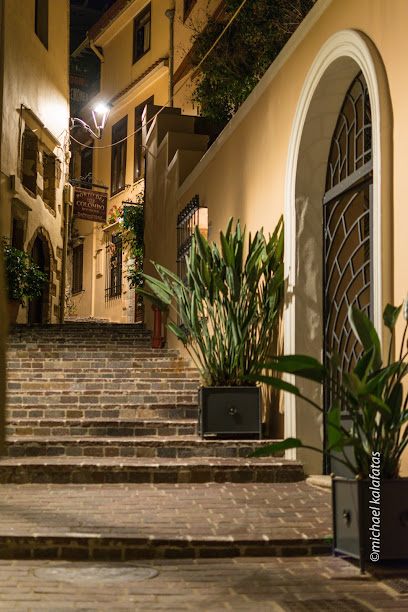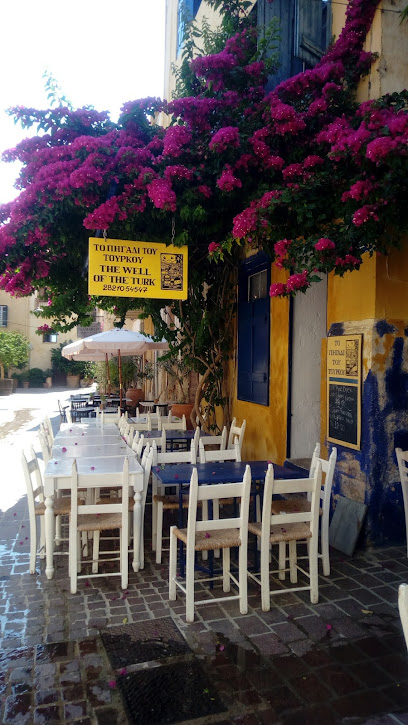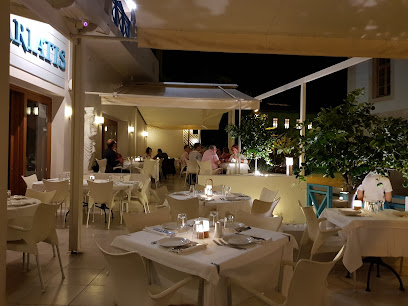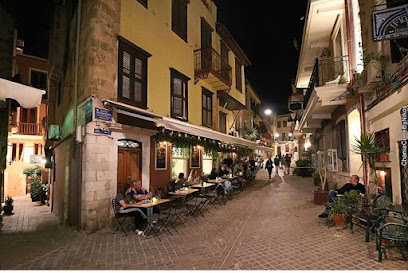
Charmed by History: Old Town in Chania
Discover the timeless allure of Old Town in Chania, Crete, where Venetian elegance meets Cretan charm, offering a captivating blend of history, culture, and modern vibrancy.
Step back in time as you wander through the enchanting alleys of Old Town in Chania, where history and culture blend seamlessly with modern-day life. This charming neighborhood, located on the northwestern coast of Crete, is a labyrinth of narrow streets and picturesque squares, each corner revealing a piece of its rich past. From the Venetian Harbor to the Turkish minarets, Old Town is a living museum of architectural and cultural influences. Begin your exploration at the iconic Venetian Harbor, where the lighthouse stands as a sentinel over the turquoise waters. Stroll along the waterfront, lined with bustling cafes and seafood tavernas, perfect for savoring local delicacies like fresh octopus and Cretan dakos. Venture deeper into the maze of streets to discover hidden gems such as the Archaeological Museum of Chania, housed in a former Venetian monastery, and the vibrant Municipal Market, offering a feast for the senses with its array of local produce and traditional goods. Old Town's charm extends beyond its historical landmarks. The neighborhood is alive with vibrant nightlife, artisanal shops, and cozy cafes. Art enthusiasts will appreciate the numerous galleries showcasing local talent, while those seeking relaxation can find solace in the serene courtyards and gardens scattered throughout. Whether you're a history buff, a foodie, or simply in search of a picturesque setting, Old Town in Chania promises an unforgettable experience.
Local tips in Old Town
- Visit the Venetian Harbor early in the morning or late afternoon to avoid the crowds and capture stunning photos.
- Wear comfortable shoes; the cobblestone streets can be uneven and require good walking footwear.
- Try the local Cretan dishes at the Municipal Market for an authentic taste of Chania.
- Take a guided walking tour to gain deeper insights into the history and hidden stories of Old Town.
- Explore the neighborhood at night when the streets are beautifully lit and local musicians often perform.
Charmed by History: Old Town in Chania
Step back in time as you wander through the enchanting alleys of Old Town in Chania, where history and culture blend seamlessly with modern-day life. This charming neighborhood, located on the northwestern coast of Crete, is a labyrinth of narrow streets and picturesque squares, each corner revealing a piece of its rich past. From the Venetian Harbor to the Turkish minarets, Old Town is a living museum of architectural and cultural influences. Begin your exploration at the iconic Venetian Harbor, where the lighthouse stands as a sentinel over the turquoise waters. Stroll along the waterfront, lined with bustling cafes and seafood tavernas, perfect for savoring local delicacies like fresh octopus and Cretan dakos. Venture deeper into the maze of streets to discover hidden gems such as the Archaeological Museum of Chania, housed in a former Venetian monastery, and the vibrant Municipal Market, offering a feast for the senses with its array of local produce and traditional goods. Old Town's charm extends beyond its historical landmarks. The neighborhood is alive with vibrant nightlife, artisanal shops, and cozy cafes. Art enthusiasts will appreciate the numerous galleries showcasing local talent, while those seeking relaxation can find solace in the serene courtyards and gardens scattered throughout. Whether you're a history buff, a foodie, or simply in search of a picturesque setting, Old Town in Chania promises an unforgettable experience.
Iconic landmarks you can’t miss
Old Venetian Port of Chania
Explore the Old Venetian Port of Chania, where history meets beauty in the heart of Crete's enchanting harbor.

Talos Square
Experience the lush beauty and vibrant atmosphere of Talos Square, a must-visit park in the heart of Chania, Greece.

Sabbionara Bastion
Discover the enchanting Sabbionara Bastion in Chania, Greece; a historical landmark offering breathtaking views and a glimpse into the city’s storied past.

Kastélli
Explore the historical landmark of Kastélli in Chania, where ancient charm meets modern culture in a picturesque setting.

Ottoman fountain
Explore the Ottoman Fountain in Chania, a beautiful historical landmark embodying the island's rich cultural heritage amidst vibrant local life.

Byzantine/Post-Byzantine Collection of Chania | Βυζαντινή/Μεταβυζαντινή Συλλογή Χανίων
Explore the rich cultural legacy of Crete at the Byzantine/Post-Byzantine Collection in Chania, a museum showcasing exquisite artifacts and religious art.

Byzantine Walls Of Chania
Discover the rich history and breathtaking views at the Byzantine Walls of Chania, a must-see historical landmark in Crete.

Byzantine Walls
Explore the Byzantine Walls in Chania, a historical fortress offering stunning views and insights into the rich past of this beautiful Cretan city.

Statue von Athenagoras I
Discover the Statue von Athenagoras I in Chania, a historical landmark that beautifully encapsulates the rich heritage and culture of Crete.

Chania Back Alleys
Explore the enchanting back alleys of Chania, a historic gem filled with stunning architecture, local culture, and hidden treasures waiting to be discovered.

Konaki/Seragio
Discover the captivating history and architectural beauty of Konaki/Seragio, a must-visit historical landmark in the heart of Chania, Greece.

Unmissable attractions to see
Chania Municipal Garden
Explore the Chania Municipal Garden, a serene community oasis filled with exotic plants, cultural events, and beautiful landscapes in the heart of Crete.

Byzantine Walls Of Chania
Discover the enchanting Byzantine Walls of Chania, a historical landmark that showcases the rich cultural heritage of Crete.

Essential places to dine
PALLAS
Experience exceptional Mediterranean dining at Pallas in Chania—where culinary artistry meets stunning seaside views.

TAMAM RESTAURANT CHANIA
Experience authentic Cretan cuisine at Tamam Restaurant in Chania's historic Old Harbour – a culinary journey you won't forget.

TO XANI Restaurant
Indulge in traditional Greek flavors at TO XANI Restaurant in Chania's enchanting Venetian Old Port.

Kouzina e.p.e.
Experience authentic Cretan cuisine at Kouzina e.p.e., where traditional flavors meet modern dining in the heart of Chania.

Oinopiio
Experience authentic Greek flavors at Oinopiio in Chania - a culinary haven that captures the essence of Cretan cuisine.

Arismari, Cretan Creative Cuisine - Αρισμαρί, Από Την Κρητική Γη
Discover authentic Cretan cuisine at Arismari in Chania – where tradition meets creativity for an unforgettable dining experience.

Colombo Kitchen & Bar
Experience authentic Cretan cuisine at Colombo Kitchen & Bar in Chania - where tradition meets modern culinary artistry.

Zepos Restaurant
Experience authentic Greek flavors at Zepos Restaurant in Chania - where every dish tells a story.

Kariatis Restaurant
Discover exquisite Italian and seafood dining at Kariatis Restaurant in Chania's historic Old Harbour—where every meal is a delightful experience.

MonEs
Discover MonEs: A Culinary Delight in Chania Offering Unique Flavors and Exceptional Service.

Markets, malls and hidden boutiques
Temple Gift Shop
Explore the Temple Gift Shop for unique souvenirs and exquisite mosaic lamps, reflecting the rich culture of Chania.

KURKUTA
Discover unique Greek souvenirs at KURKUTA in Chania, where local craftsmanship meets vibrant artistry for an unforgettable shopping experience.

Eleonora Boutique Chania
Explore Eleonora Boutique Chania for a unique selection of women's fashion, accessories, and leather goods in the heart of Chania, Greece.

Secret Paradise Chania
Explore Secret Paradise Chania for unique gifts and local treasures that capture the spirit of Crete, perfect for souvenirs and special keepsakes.

Mini Art Shop
Explore Mini Art Shop in Chania for exquisite handmade ceramics, local art, and unique gifts that embody the spirit of Crete.

Elephant Store
Explore the Elephant Store in Chania for unique gifts, local artisan products, and memorable souvenirs that capture the spirit of Crete.

Canea T Shirt Souvenirs
Explore the charm of Canea T Shirt Souvenirs in Chania, where quality gifts and unique apparel await to capture your Crete memories.

Anastasia Store
Discover unique fashion finds at Anastasia Store in Chania, Greece, your go-to destination for clothing, accessories, and local style.

Agora Products Boutique
Discover unique gifts and local crafts at Agora Products Boutique in Chania, a must-visit destination for souvenirs and cultural treasures.

Anemi
Explore Anemi Gift Shop in Chania for unique Cretan souvenirs, handcrafted treasures, and a taste of local culture that captures the spirit of Greece.

Essential bars & hidden hideouts
Sinagogi coctail bar
Experience Chania's vibrant nightlife at Sinagogi Cocktail Bar, where unique cocktails and a cozy ambiance await every visitor.

Το μοναστήρι του καρόλου
Discover the Monastery of Karolos, a cocktail bar in Chania offering innovative drinks and a serene garden atmosphere for the perfect getaway.

Avalon Rock Pub Chania
Discover the lively Avalon Rock Pub in Chania, where the music is vibrant, the drinks are diverse, and the nightlife is unforgettable.

Fagotto Jazz Bar Chania
Discover the soulful sounds and vibrant nightlife at Fagotto Jazz Bar, a top destination in Chania for jazz enthusiasts and cocktail lovers alike.

Plaka
Experience the vibrant atmosphere of Plaka in Chania, where delicious food and cocktails meet warm Greek hospitality.

Peacock Tail Bar
Experience the vibrant nightlife of Chania at Peacock Tail Bar, where innovative cocktails meet a lively atmosphere.

Ka Mon Irish Pub & Bar
Immerse yourself in Irish culture at Ka Mon Irish Pub & Bar, where hearty food, friendly faces, and festive nights await in Chania.

Βoulevard of broken dreams
Discover the vibrant nightlife of Chania at the Boulevard of Broken Dreams, where cocktails and camaraderie come alive in a stunning bar setting.

Synapsis - Gathering Bar
Discover the vibrant nightlife at Synapsis, Chania's premier gathering bar featuring exceptional drinks and an inviting atmosphere.

No Name All Day Bar
Discover Chania's vibrant nightlife at No Name All Day Bar, your go-to spot for refreshing drinks and a welcoming atmosphere.

Local Phrases
-
- HelloΓεια σας
[Yah sas] - GoodbyeΑντίο
[Adio] - YesΝαι
[Neh] - NoΌχι
[Ohi] - Please/You're welcomeΠαρακαλώ
[Parakalo] - Thank youΕυχαριστώ
[Efharisto] - Excuse me/SorryΣυγνώμη
[Signomi] - How are you?Τι κάνετε;
[Tee kanete] - Fine. And you?Καλά. Εσείς;
[Kala. Esis] - Do you speak English?Μιλάτε Αγγλικά;
[Milate Anglika] - I don't understandΔεν καταλαβαίνω
[Den katalaveno]
- HelloΓεια σας
-
- I'd like to see the menu, pleaseΘα ήθελα να δω το μενού, παρακαλώ
[Tha ithela na do to menou, parakalo] - I don't eat meatΔεν τρώω κρέας
[Den troo kreas] - Cheers!ΥΓΕΙΑ!
[Yia] - I would like to pay, pleaseΘα ήθελα να πληρώσω, παρακαλώ
[Tha ithela na plirosso, parakalo]
- I'd like to see the menu, pleaseΘα ήθελα να δω το μενού, παρακαλώ
-
- Help!Βοήθεια!
[Voithia] - Go away!Φύγε!
[Fiye] - Call the Police!Καλέστε την Αστυνομία!
[Kaleste tin Astinomia] - Call a doctor!Καλέστε γιατρό!
[Kaleste yatro] - I'm lostΈχω χαθεί
[Eho hathee] - I'm illΕίμαι άρρωστος
[Emai arrostos]
- Help!Βοήθεια!
-
- I'd like to buy...Θα ήθελα να αγοράσω...
[Tha ithela na agoraso] - I'm just lookingΑπλά κοιτάω
[Apla kitao] - How much is it?Πόσο κοστίζει;
[Poso kostizi] - That's too expensiveΑυτό είναι πολύ ακριβό
[Afto ine poli akribo] - Can you lower the price?Μπορείτε να μειώσετε την τιμή;
[Borite na meiosete tin timi]
- I'd like to buy...Θα ήθελα να αγοράσω...
-
- What time is it?Τι ώρα είναι;
[Tee ora ine] - It's one o'clockΕίναι μία ώρα
[Ine mia ora] - Half past (10)Μισή (10)
[Misi (dekka)] - MorningΠρωί
[Proi] - AfternoonΑπόγευμα
[Apoyevma] - EveningΒράδυ
[Vradi] - YesterdayΧθες
[Hthes] - TodayΣήμερα
[Simera] - TomorrowΑύριο
[Avrio] - 1Ένα
[Ena] - 2Δύο
[Dio] - 3Τρία
[Tria] - 4Τέσσερα
[Tessera] - 5Πέντε
[Pente] - 6Έξι
[Exi] - 7Εφτά
[Efta] - 8Οχτώ
[Ochto] - 9Εννέα
[Ennea] - 10Δέκα
[Deka]
- What time is it?Τι ώρα είναι;
-
- Where's a/the...?Πού είναι ένα/το...;
[Pou ine ena/to] - What's the address?Ποια είναι η διεύθυνση;
[Pia ine i diefthinsi] - Can you show me (on the map)?Μπορείτε να μου δείξετε (στο χάρτη);
[Borite na mou dixete (sto charti)] - When's the next (bus)?Πότε είναι το επόμενο (λεωφορείο);
[Pote ine to epomeno (leoforeio)] - A ticket (to ....)Ένα εισιτήριο (για ....);
[Ena isitirio (ya)]
- Where's a/the...?Πού είναι ένα/το...;
History of Old Town
-
Chania's Old Town began to take shape during the Venetian occupation, which started in 1252. The Venetians transformed the city into a thriving port and trade hub, constructing impressive fortifications, churches, and public buildings that reflect the Renaissance architectural style. The harbor, lined with Venetian-style buildings, remains a testament to this period, particularly the iconic lighthouse that stands as a beacon of the city’s maritime heritage.
-
Following the fall of Chania to the Ottomans in 1645, the Old Town experienced significant cultural shifts. The Ottomans introduced their architectural style, evident in the numerous mosques and fountains that punctuate the landscape. The Yali Mosque, located at the harbor, is a prime example of this influence, showcasing the blend of Byzantine, Venetian, and Ottoman architecture that characterizes Chania's unique urban fabric.
-
During World War II, Chania played a strategic role in the Battle of Crete. The Old Town was subjected to heavy bombardment as Allied forces attempted to defend the island from German invasion. The remnants of this conflict can still be seen in various parts of the Old Town, with memorials and historical markers commemorating the sacrifices made during this tumultuous period.
-
In the post-war era, Chania's Old Town underwent significant reconstruction as it began to embrace tourism as a vital part of its economy. The restoration of historical buildings and the promotion of local culture attracted visitors from around the world. Today, Old Town is a vibrant area, bustling with shops, tavernas, and cultural events that celebrate the rich history and traditions of Chania and Crete.
-
Chania's Old Town is not only a historical site but also a cultural hub where numerous festivals take place throughout the year. Events such as the Chania Wine Festival and the Rethymno Carnival showcase the region's rich traditions, gastronomy, and arts, drawing both locals and tourists to celebrate the vibrant Cretan culture. These events help preserve the heritage of the area and foster a sense of community among residents.
Old Town Essentials
-
Old Town Chania is easily accessible from various neighborhoods within the city. If you are coming from the New Town, it’s a 15-20 minute walk along the waterfront promenade. Local buses run frequently from various parts of Chania, including the bus station near the Old Port. For those arriving from the Chania International Airport, taxis are available, and the ride takes approximately 20-30 minutes depending on traffic. Car rentals are also an option, but parking in Old Town can be limited.
-
Old Town is best explored on foot due to its narrow, winding streets that are not accessible by car. Bicycles can be rented, and some areas have bike lanes, but be cautious of pedestrian traffic. Public transportation options include local buses that connect to other parts of Chania, but within Old Town, walking is the most practical way to navigate.
-
Old Town Chania is generally safe for tourists, but as with any popular tourist destination, standard precautions should be taken. Avoid walking alone late at night in poorly lit areas. Pickpocketing can occur in crowded spots, especially in markets and during peak tourist seasons. While there are no specific high-crime areas targeting tourists, it's wise to stay alert and keep personal belongings secure.
-
In case of an emergency, dial 112 for police, fire, or medical assistance. The nearest hospital is the Chania General Hospital, located a short drive from Old Town. There are also several pharmacies within Old Town for minor health issues. It's advisable to have travel insurance that includes medical coverage.
-
Fashion: Do dress modestly if visiting churches or monasteries. Avoid beachwear outside of the beach areas. Religion: Do respect local customs, including observing quietness in places of worship. Public Transport: Do be respectful on buses and give priority to the elderly. Don't consume food or drinks on public transport. Greetings: Do greet locals with a friendly 'Kalimera' (Good morning) or 'Kalispera' (Good evening). Eating & Drinking: Do try traditional Cretan dishes and support local tavernas. Don’t waste food or leave large amounts on your plate, as this is considered disrespectful.
-
To experience Old Town like a local, visit the local markets early in the morning for fresh produce and traditional goods. Engage with shopkeepers and locals to learn about the history and culture of Chania. Don’t miss the chance to explore the lesser-known alleys and hidden squares away from the main tourist routes. Enjoy a coffee at a local kafeneio (coffee shop) and take time to people-watch. If you're interested in history, ask about guided tours that delve into Chania’s rich past.
Trending Landmarks in Old Town
Nearby Cities to Old Town
-
Things To Do in Rethymno
-
Things To Do in Crete
-
Things To Do in Heraklion
-
Things To Do in Pyrgos
-
Things To Do in Santorini
-
Things To Do in Kalamata
-
Things To Do in Mykonos
-
Things To Do in Nafplio
-
Things To Do in Athens
-
Things To Do in Olympia
-
Things To Do in Kos
-
Things To Do in Bodrum
-
Things To Do in Delphi
-
Things To Do in Samos
-
Things To Do in Patras













